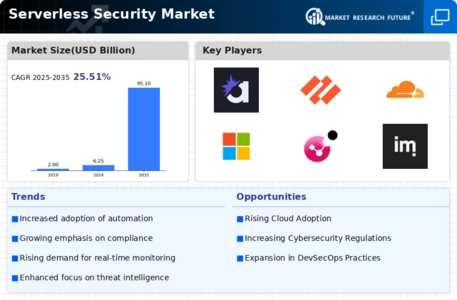Regulatory Compliance Requirements
Regulatory compliance requirements are becoming increasingly stringent, which serves as a significant driver for the Serverless Security Market. Organizations must adhere to various regulations, such as GDPR and HIPAA, which mandate the protection of sensitive data. As serverless architectures become more prevalent, ensuring compliance within these environments poses unique challenges. Companies are therefore seeking security solutions that not only protect their applications but also facilitate compliance with regulatory standards. This need for compliance-driven security solutions is likely to stimulate growth in the Serverless Security Market, as businesses prioritize adherence to legal requirements.
Growing Cybersecurity Threat Landscape
The evolving cybersecurity threat landscape significantly influences the Serverless Security Market. With the rise of sophisticated cyber threats, organizations are compelled to enhance their security postures. Data breaches and cyberattacks have become increasingly prevalent, prompting businesses to seek advanced security solutions. The serverless model, while offering numerous benefits, also introduces new vulnerabilities that attackers may exploit. As a result, the demand for security solutions that can address these specific risks is expected to increase. This trend indicates a growing recognition of the importance of serverless security, thereby driving the Serverless Security Market.
Increased Investment in Cloud Security
The surge investment in cloud security solutions is a critical driver for the Serverless Security Market. Organizations are allocating substantial resources to enhance their cloud security frameworks, recognizing the importance of protecting their digital assets. Recent reports suggest that spending on cloud security is expected to exceed $30 billion by 2026. This trend reflects a growing awareness of the vulnerabilities associated with cloud environments, including serverless architectures. As businesses prioritize security in their cloud strategies, the demand for specialized serverless security solutions is anticipated to grow, further propelling the Serverless Security Market.
Rising Adoption of Serverless Architectures
The increasing adoption of serverless architectures is a primary driver for the Serverless Security Market. Organizations are increasingly shifting towards serverless computing due to its scalability and cost-effectiveness. According to recent estimates, the serverless computing market is projected to grow at a compound annual growth rate of over 20% in the coming years. This shift necessitates robust security measures tailored to the unique challenges posed by serverless environments. As businesses embrace this model, the demand for specialized security solutions that can effectively protect serverless applications is likely to surge, thereby propelling the Serverless Security Market forward.
Integration of Advanced Security Technologies
The integration of advanced security technologies, such as artificial intelligence and machine learning, is a notable driver for the Serverless Security Market. These technologies enhance the ability to detect and respond to threats in real-time, which is crucial in serverless environments where traditional security measures may fall short. The market for AI-driven security solutions is expected to expand significantly, with projections indicating a growth rate of over 25% in the next few years. As organizations increasingly recognize the value of these technologies in fortifying their serverless applications, the demand for innovative security solutions is likely to rise, thereby benefiting the Serverless Security Market.

















Leave a Comment